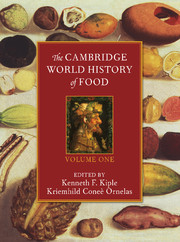Book contents
- Frontmatter
- Introduction
- Part I Determining What Our Ancestors Ate
- Part II Staple Foods: Domesticated Plants and Animals
- II.A Grains
- II.B Roots, Tubers, and Other Starchy Staples
- II.C Important Vegetable Supplements
- II.D Staple Nuts
- II.E Animal, Marine, and Vegetable Oils
- II.F Trading in Tastes
- II.G Important Foods from Animal Sources
- II.G.1 American Bison
- II.G.2 Aquatic Animals
- II.G.3 Camels
- II.G.4 Caribou and Reindeer
- II.G.5 Cattle
- II.G.6 Chickens
- II.G.7 Chicken Eggs
- II.G.8 Dogs
- II.G.9 Ducks
- II.G.10 Game
- II.G.11 Geese
- II.G.12 Goats
- II.G.13 Hogs (Pigs)
- II.G.14 Horses
- II.G.15 Insects
- II.G.16 Llamas and Alpacas
- II.G.17 Muscovy Ducks
- II.G.18 Pigeons
- II.G.19 Rabbits
- II.G.20 Sea Turtles and Their Eggs
- II.G.21 Sheep
- II.G.22 Turkeys
- II.G.23 Water Buffalo
- II.G.24 Yak
- Part III Dietary Liquids
- Part IV The Nutrients – Deficiencies, Surfeits, and Food-Related Disorders
- References
II.G.22 - Turkeys
from II.G - Important Foods from Animal Sources
Published online by Cambridge University Press: 28 March 2008
- Frontmatter
- Introduction
- Part I Determining What Our Ancestors Ate
- Part II Staple Foods: Domesticated Plants and Animals
- II.A Grains
- II.B Roots, Tubers, and Other Starchy Staples
- II.C Important Vegetable Supplements
- II.D Staple Nuts
- II.E Animal, Marine, and Vegetable Oils
- II.F Trading in Tastes
- II.G Important Foods from Animal Sources
- II.G.1 American Bison
- II.G.2 Aquatic Animals
- II.G.3 Camels
- II.G.4 Caribou and Reindeer
- II.G.5 Cattle
- II.G.6 Chickens
- II.G.7 Chicken Eggs
- II.G.8 Dogs
- II.G.9 Ducks
- II.G.10 Game
- II.G.11 Geese
- II.G.12 Goats
- II.G.13 Hogs (Pigs)
- II.G.14 Horses
- II.G.15 Insects
- II.G.16 Llamas and Alpacas
- II.G.17 Muscovy Ducks
- II.G.18 Pigeons
- II.G.19 Rabbits
- II.G.20 Sea Turtles and Their Eggs
- II.G.21 Sheep
- II.G.22 Turkeys
- II.G.23 Water Buffalo
- II.G.24 Yak
- Part III Dietary Liquids
- Part IV The Nutrients – Deficiencies, Surfeits, and Food-Related Disorders
- References
Summary
The process of capture, taming, and eventual domestication of most animals is a difficult and lengthy process, often consisting of a trial-and-error approach. One notable exception was the domestication of the North American wild turkey, Meleagris gallopavo. The U.S. National Park Service archaeologist Jean Pinkley, while stationed at Mesa Verde National Park, put forth a logical scenario outlining the unique process of taming and domesticating the prehistoric pueblo turkeys of that area. Pinkley (1965) has pointed out that some domesticated animals apparently first exploited humans before becoming another of their agricultural conquests. The turkey is such an example.
The pueblo turkeys had become extinct in the Mesa Verde area by historic times, and the Park Service reintroduced breeding stock in 1944 (Pinkley 1965). This permitted observation of the wild turkeys and their relationship with the employees of the park. The turkeys were timid at first, but as they learned where food could be found – in this case, feeding stations that the government set out for small birds – they took over these sources. They also moved into warm roosting places available in the park’s residential areas, and despite efforts to chase them away by tossing Fourth of July cherry bombs and firing guns into the air, the birds continued to congregate in and around park dwellings.
There is little reason to believe that prehistoric humans in Mesa Verde were not tormented by turkeys in much the same manner, and sooner or later, when it dawned on them that the birds could not be driven off or frightened away, the Pueblo Indians would out of despair have begun to corral them to protect crops and foodstores. At this point, recognition of the turkey as a source of food and materials for bone tools would presumably have been a logical next step.
- Type
- Chapter
- Information
- The Cambridge World History of Food , pp. 578 - 583Publisher: Cambridge University PressPrint publication year: 2000
References
- 1
- Cited by

